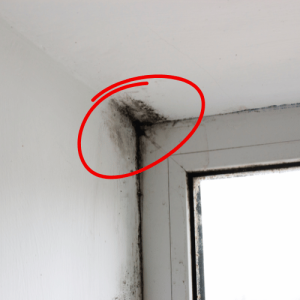
Credit: Nikolay Malshakov from Getty Images; designed in Canva
Mold Detection
Molds are a type of fungi that are nearly invisible to the naked eye…until that is, they begin to “fruit.” While this “fruit” is about as far from an apple as you can get, it does serve the same purpose in helping the fungus reproduce. The fruiting bodies, which come in a wide range of sizes, textures, and colors, release spores into the atmosphere. These spores can sometimes exacerbate allergies or cause irritation when inhaled. Under certain circumstances, some molds can also produce mycotoxins, which are harmful to our health and may be linked to various types of disease.
Experts estimate that there are approximately 100,000 species of mold. The truth is that we are almost always exposed to some form of mold, but the majority of it is harmless. In fact, many molds are crucial in the decomposition process, helping break down organic material and returning important nutrients back to the earth. The small minority of it that isn’t safe, however, can pose some detrimental risks to our health. That’s why it’s important to know how mold grows, when to be concerned, and ways to both manage and prevent it.
Conditions for Growth
You may have heard this before, but you can’t have mold without moisture. Most molds will do best at over 60% relative humidity, which is why they are often found in bathrooms, kitchens, and other spaces where there is the frequent use of running water. You can measure a room’s relative humidity with the use of a hygrometer.
Beyond high humidity levels, mold requires an appropriate medium to grow on. It often favors cellulose materials, such as wood, paper, and cardboard. However, you can find many molds on drywall, tiles, natural fibers, paint, and even insulation.
Finally, your indoor temperature may encourage mold growth. To discourage growth while remaining energy-efficient, it’s recommended that your thermostat should be set no lower than 78°F in the summer and no higher than 68°F in the winter. Additionally, turning your thermostat down too quickly may increase the relative humidity within your indoor space.
So, the informal mold equation is as follows…

mold = (humidity >60%) + (ideal temperature) + (suitable growth medium)
Although mold infestations can happen at any time given the right conditions, the risk is higher following a storm event due to water intrusion from flooding or leaks. If not promptly fixed, water intrusion can lead to higher relative humidity and create an ideal environment for mold growth. It is important to be proactive and act quickly after these events, especially if you find signs of mold in your living quarters.
Signs of Mold
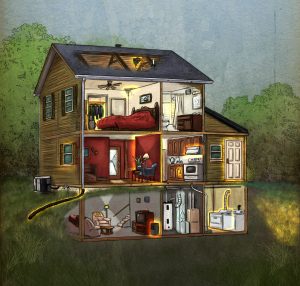
Credit: EPA
As mentioned earlier, the fruiting bodies of mold come in a variety of colors and can be easily spotted once established. Look around the home for spots that are white, grey, black, yellow, or green in appearance. These spots can vary in size and texture depending on the mold species.
Where to check for mold:
- Furniture
- Walls
- Ceilings
- Tiles
- Grout
- Wood
Besides looking for visual symptoms of mold growth, you can also use your nose as a means of sniffing out a potential problem. Many molds have a distinctively musty or earthy odor. If you do see or smell mold, further examine the area for signs of water damage. This can help determine the source of the problem.
Testing Kits
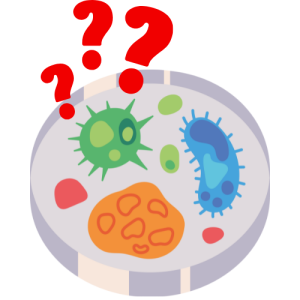 Most of the time, identifying mold based on visuals or smell alone can be extremely difficult to impossible. That said, commercially available mold testing kits are often unreliable and can result in false negatives, potentially leaving you and your family at risk of continued exposure. At this time, there are also no health or exposure-based standards for evaluating mold samples.
Most of the time, identifying mold based on visuals or smell alone can be extremely difficult to impossible. That said, commercially available mold testing kits are often unreliable and can result in false negatives, potentially leaving you and your family at risk of continued exposure. At this time, there are also no health or exposure-based standards for evaluating mold samples.
The Florida Department of Health does not recommend that you test for mold at home. Instead, recruit a professional to help you determine the extent of the mold problem and any necessary treatment. Although not all mold presents a danger, prolonged exposure to many common indoor species may result in adverse health effects. It’s always better to err on the side of caution if you suspect an infestation!
Dangers of Mold
Mold is classified as a “biological pollutant”. This means it is a living (or once-living) microorganism that is harmful to our health if inhaled or ingested. Health impacts from mold are serious and can become life-threatening if left untreated. Here are some symptoms you may experience if you’re living with a mold growth, and the resulting long-term consequences:
- Short-term symptoms: Short-term exposure to mold will cause allergic reactions or allergy-related symptoms, such as coughing, sneezing, headaches, and eye/throat irritation.
- Long-term consequences: Exposure to mold over long periods of time will lead to lung damage, respiratory diseases, and chronic allergies, if left untreated. Research has also shown a possible link between autoimmune disorders and long-term mold exposure.
While mold affects everyone, some groups are particularly vulnerable. People who are the most at-risk include children, senior citizens, and people with pre-existing respiratory or immune system conditions. Pets inside your home are also especially vulnerable to health impacts from mold growths.
Mold Remediation
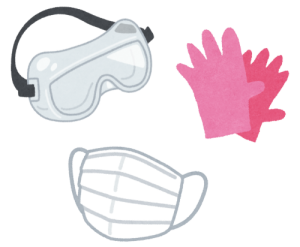 For small, easy-to-manage areas, you can often take on the task of cleaning mold by yourself. Here are some tips for mold remediation in the home:
For small, easy-to-manage areas, you can often take on the task of cleaning mold by yourself. Here are some tips for mold remediation in the home:
- Fix leaks or other water problems first: Before you can properly manage and prevent mold, you’ll need to fix any leaks or other instances of water intrusion. If needed, hire a plumber or water damage restoration specialist.
- Wear personal protective equipment (PPE): Use long gloves made of rubber, neoprene, nitrile, polyurethane or PVC, safety goggles without ventilation holes, and an N95 mask to protect your hands, eyes, and respiratory system from unwanted contact with mold or cleaning chemicals. Long sleeves, pants, and socks will offer additional protection in the case of splashes or spills.
- Remove standing water and wet materials: If applicable, use a wet vacuum to remove any instances of standing water. Wet items should be cleaned and dried within 48 hours. Unfortunately, this may not always be possible, especially if there is a power outage. For cases where items cannot be properly handled within that timeframe, it is best to throw them out. If you plan to replace them through your home or renter’s insurance, make sure to take pictures beforehand.
- Don’t hesitate to ventilate: Properly ventilating your house is a fast and reliable way to reduce moisture, discouraging further mold growth! You can increase ventilation by temporarily opening your doors and windows.
- If you suspect water intrusion in your cabinets, drawers, or closets, keep them open until they have completely dried and the source of moisture has been removed.
- Do not use fans if mold is present in the home, as it can further spread spores.
- Use a dehumidifier: Dehumidifiers reduce your home’s levels of moisture, making them another handy tool in mold management.
- Inspect your HVAC: Occasionally, mold can enter our heating/ventilation/air conditioning (HVAC) system. If you suspect that this has happened to your home, turn off your system to prevent the spread of mold and check your air ducts. If you see visible mold growth, you will need to hire a duct cleaning service to remove it from the system.
 Don’t default to harsh cleaning chemicals: While bleach may effectively kill mold, it can also cause harm if mishandled. It also will not fix the problem if high humidity is still present. In many cases, you can use water with soap or detergent to clean visible mold on non-porous materials. Absorbent or porous materials that are infested with mold may not be salvageable. For items with sentimental value, consider consulting a specialist for advice on how to clean or restore your item. Make sure to dry all items after cleaning.
Don’t default to harsh cleaning chemicals: While bleach may effectively kill mold, it can also cause harm if mishandled. It also will not fix the problem if high humidity is still present. In many cases, you can use water with soap or detergent to clean visible mold on non-porous materials. Absorbent or porous materials that are infested with mold may not be salvageable. For items with sentimental value, consider consulting a specialist for advice on how to clean or restore your item. Make sure to dry all items after cleaning.
- If you do decide to use bleach, do not mix it with any other cleaning products. This can lead to unexpected and sometimes deadly reactions, especially in the case of bleach and ammonia.
- Be thorough: Make sure to remove all visible mold in the home. If you are uncertain about whether there is still mold present in the home, ask a professional for assistance.
In some situations, it may not be practical or even feasible to clean all the mold within your home. Know your limits and remember to ask for expert help in cases of large or unruly mold outbreaks.
When to Hire a Professional Service
Not all mold can be easily and thoroughly cleaned. If you still see or smell mold after cleaning or your infestation is greater than 10 square feet, it is recommended that you hire a professional service to help with remediation efforts.
Start with asking friends, family, or neighbors who they recommend. You can also take online ratings and reviews into consideration. Once you have your list of possible services together, you’ll want to check a few things first before making your final selection.

When searching for a mold remediation service, make sure that they are fully accredited. In Florida, all mold remediation specialists are legally required to hold a license from the Department of Business and Professional Regulation (DBPR). In addition, look for at least one of the following affiliations or certifications:
- National Environmental Health Association (NEHA)
- American Industrial Hygiene Association (AIHA)
- Institute of Inspection, Cleaning and Restoration Certification (IICRC)
- American Council for Accredited Certification (ACAC)
This information is often available on their website, but if not, you can ask over the phone or in person. Any individuals or companies should also be insured. You can ask for a certificate of insurance (COI) to verify.
Always ask for an inspection before paying for any services. While they may not always be free, inspections are an important first step in determining the extent of a mold infestation and the subsequent course of treatment. It may also be a good idea to ask how long the treatment process will be, so you can plan accordingly.
If, after the inspection, you receive an unexpectedly high quote for treatment, reach out to at least one other service to compare price points. You can use this information to determine your next steps. Remember that financing may be available, and some insurance policies may help cover costs. There are also more resources for financial assistance included later in this blog.
Mold Prevention
The best strategy for getting rid of mold is to prevent it from growing in the first place! Follow the tips below to ensure your home is not mold-friendly:
- Consider an air purifier or dehumidifier: Air purifiers will filter the air in your home and can also sanitize it, removing harmful allergens and microorganisms – like mold! Dehumidifiers reduce your home’s levels of moisture, which can limit the ability of mold to grow.
- Keep ventilating: Properly ventilating your house is a fast and reliable way to reduce the moisture level and concentration of mold particles, also making your home more comfortable! You can increase ventilation by opening windows for short periods of time and using exhaust fans in the kitchen and bathroom.
- Plants as purifiers: Many indoor plants absorb toxic chemicals from the air and ‘digest’ them so they become harmless. Plants are an affordable alternative to air purifiers too, because they don’t use electricity! Common examples: golden pothos, rubber plant, peace lily. Note: These plants can be toxic to pets.
Financial Assistance

In most cases, if your home is insured, checking your policy for mold-related coverage is the best first step. Flood and homeowner’s insurance policies can be confusing to navigate, so we recommend contacting your insurance provider for specifics about your situation.
After a disaster, you may be eligible for funds through the Federal Emergency Management Agency (FEMA). You can apply for assistance using their online form.
You must meet the following criteria to quality for aid (from FEMA):
- Only United States citizens, non-citizen nationals, or qualified non-citizens are eligible to receive assistance from FEMA.
- You need to prove your identity with a valid Social Security number.
- For certain types of assistance, FEMA must confirm the disaster-damaged home is your primary residence. For Home Repair or Replacement Assistance, FEMA also needs to confirm you owned the residence at the time of the disaster.
- FEMA cannot provide assistance for disaster needs that have already been met by another source, like insurance or other programs.
- But, if your insurance or another program does not cover all your disaster-caused needs, you may be eligible for assistance from FEMA.
Learn More
- Florida Department of Health – Indoor Mold and Your Health: https://www.floridahealth.gov/environmental-health/mold/index.html
- Center for Disease Control – Homeowner’s and Renter’s Guide to Mold Cleanup After Disasters: https://www.cdc.gov/mold-health/media/Homeowners_and_Renters_Guide.pdf
- Center for Disease Control – 8 Tips to Clean Up Mold: https://www.cdc.gov/mold-health/media/pdfs/2024/03/mold-cleanup.pdf
- Environmental Protection Agency – A Brief Guide to Mold, Moisture and Your Home: https://www.epa.gov/mold/brief-guide-mold-moisture-and-your-home
- UF/IFAS Extension, Judy Corbus – Goodbye, Mold!: https://nwdistrict.ifas.ufl.edu/fcs/2021/05/12/goodbye-mold/
- UF/IFAS Extension Sarasota County’s Healthy Homes webinar: Watch a recording of our “Healthy Homes” webinar, which goes over safe and healthy ways to keep your home clean, pest-free, and efficient. The YouTube recording is found here: https://www.youtube.com/watch?v=3t4zQHNmXpw&t=7s
- Check out our website: https://www.scgov.net/government/sustainability/sustainability
- Visit our Eventbrite and keep your eye out for upcoming classes: https://www.eventbrite.com/o/ufifas-extension-sarasota-county-422952084
Credits
- Featured image: Gustavo Mellossa from Getty Images; designed in Canva
- Photos: As credited in caption
- Graphics: Designed in Canva
- Sources: Linked within the blog
 9
9
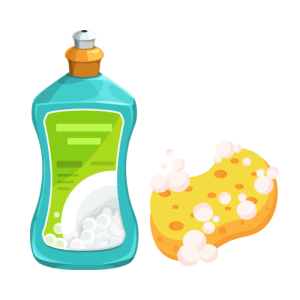 Don’t default to harsh cleaning chemicals: While bleach may effectively kill mold, it can also cause harm if mishandled. It also will not fix the problem if high humidity is still present. In many cases, you can use
Don’t default to harsh cleaning chemicals: While bleach may effectively kill mold, it can also cause harm if mishandled. It also will not fix the problem if high humidity is still present. In many cases, you can use 